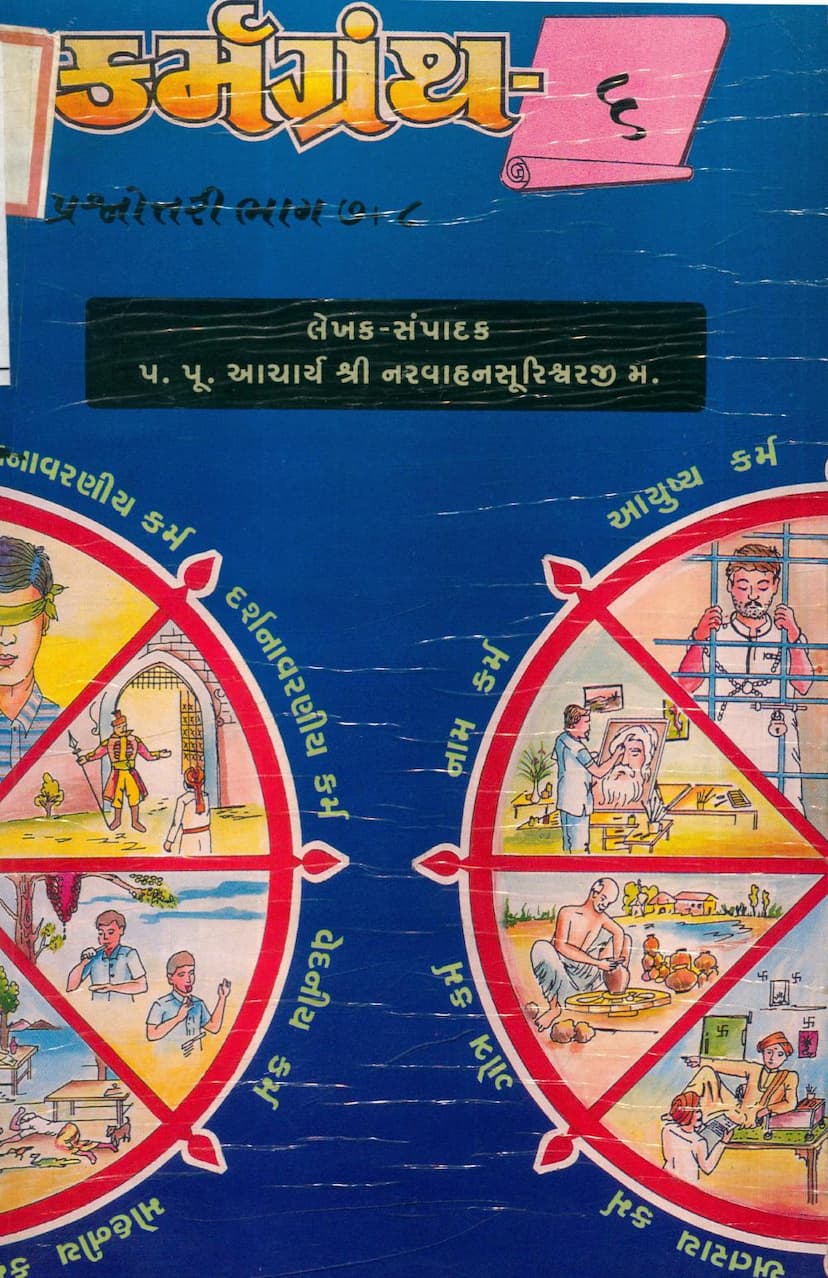Karmgranth 6 Prashnottari Part 07 08
Added to library: September 2, 2025
Loading image...

Summary
This document is Volume 6, Parts 7 and 8 of the "Karmgranth" series in Gujarati, authored by Narvahanvijay and published by Padarth Darshan Trust. The series is presented in a question-and-answer format.
Key Aspects and Content:
- Subject Matter: The text is primarily concerned with the intricate details of karma (actions and their consequences) according to Jain philosophy. It delves into the classification, operation, and manifestation of karmic influxes (bandh, uday, satta) in relation to various spiritual stages (gunasthanas), life forms, sensory capabilities, psychological states, knowledge types, and states of consciousness.
- Format: It is a question-and-answer compilation, addressing specific queries related to karmic principles.
- Author and Publisher: The author is Acharya Shri Narvahan Surishwarji Maharaj, and the publisher is Padarth Darshan Trust.
- Context: The book is part of a larger series of 24 books on Jain philosophy, with previous volumes focusing on foundational concepts like soul, elements, and earlier parts of karmic analysis. This specific volume is the 24th book in the series.
- Content Breakdown (based on the page descriptions and question numbers):
- Pages 1-11: These pages contain the title, author information, publisher details, publication dates, acknowledgments, a list of other published works by the author, and information about the financial supporters of the publication.
- Pages 12-80 (Part 7): This section is dedicated to detailed karmic analysis across numerous categories. It systematically outlines the number of karmic bond, fruition, and latent states (bandh, uday, satta) for various classifications:
- Life-forms/Rebirths (Gati): Naraka (hell beings), Tiryancha (animals), Manushya (humans), Deva (celestial beings).
- Sentient beings: Ekendriya (one-sensed), Beindriya (two-sensed) up to Panchendriya (five-sensed).
- Physical types: Earth-bodied, water-bodied, fire-bodied, air-bodied, plant-bodied, and trans-corporeal beings (Trasa).
- Mental states: Mind-yog, speech-yog, body-yog.
- Genders and Passions: Male, female, neuter gender; anger, pride, delusion, greed.
- Knowledge and Perception: Mati-jnana (sense-based knowledge), Shruta-jnana (scriptural knowledge), Avadhi-jnana (clairvoyance), Manah-paryaya-jnana (mind-reading), Kevala-jnana (omniscience); and their respective ignorance counterparts.
- Stages of practice: Samayika, Chedopasthapaniya, Pariharavishuddha, Sukshma Samparaya, Yathakhyata Charitra, Deshavirati, Avirati, etc.
- Perception types: Chakshu-darshan (visual perception), Achakshu-darshan (non-visual perception), Avadhi-darshan (clairvoyant perception), Kevala-darshan (omniscience).
- Auras (Leshya): Krishna (black), Nila (blue), Kapota (pigeon-colored), Tejo (yellow), Padma (red), Shukla (white).
- States of Being: Bhavya (capable of liberation), Abhavya (incapable of liberation).
- States of Faith/Conduct: Upasham Samyakva (suppressed faith), Kshayaik Samyakva (destroyed faith), Kshaya-opasham Samyakva (partially destroyed-generated faith), Mithyatva (wrong faith), Sasavadan (tasting faith), Samayika, etc.
- Vows and Conduct: Acharya also details the number of karmic states in relation to various conduct stages, including vows and the absence thereof.
- Pages 81-144 (Part 8): This section continues the detailed karmic analysis, focusing significantly on the stages of spiritual progress (gunasthanas) and the process of purification through upashama (suppression) and kshay (destruction) of karmas. It elaborates on:
- Upasham Shreni (Path of Suppression): Detailed descriptions of the processes involved in suppressing karmas, particularly the four ananta-anubandhi passions, three types of darshana mohaniya (perception-obscuring karma), and eventually the charitra mohaniya (conduct-obscuring karma). It discusses the specific karana (processes) like Yathapravartakaraṇa, Apurovakarana, and Anivrittikaraṇa and their implications.
- Kshaya Shreni (Path of Destruction): Descriptions of the processes involved in destroying karmas, focusing on the destruction of passions and obscuring karmas to achieve omniscience and liberation.
- Stages of Karma Destruction: It details the specific karmas destroyed at different stages of spiritual progress and the associated spiritual states.
- Specific Karmas: Focus on Mohaniya Karma (delusion-causing karma), including its various subdivisions like passions (kashayas), passions disguised as virtues (nokashayas), genders (vedas), and the three types of perception-obscuring karma.
- The process of attaining liberation is explained through the stages of upashama and kshay of these karmic obstructions.
In essence, "Karmgranth 6, Prashnottari Part 07 and 08" is a highly detailed and technical manual on Jain karmic theory, providing a systematic breakdown of karmic manifestations across various existential and spiritual dimensions, crucial for understanding the path to liberation in Jainism.